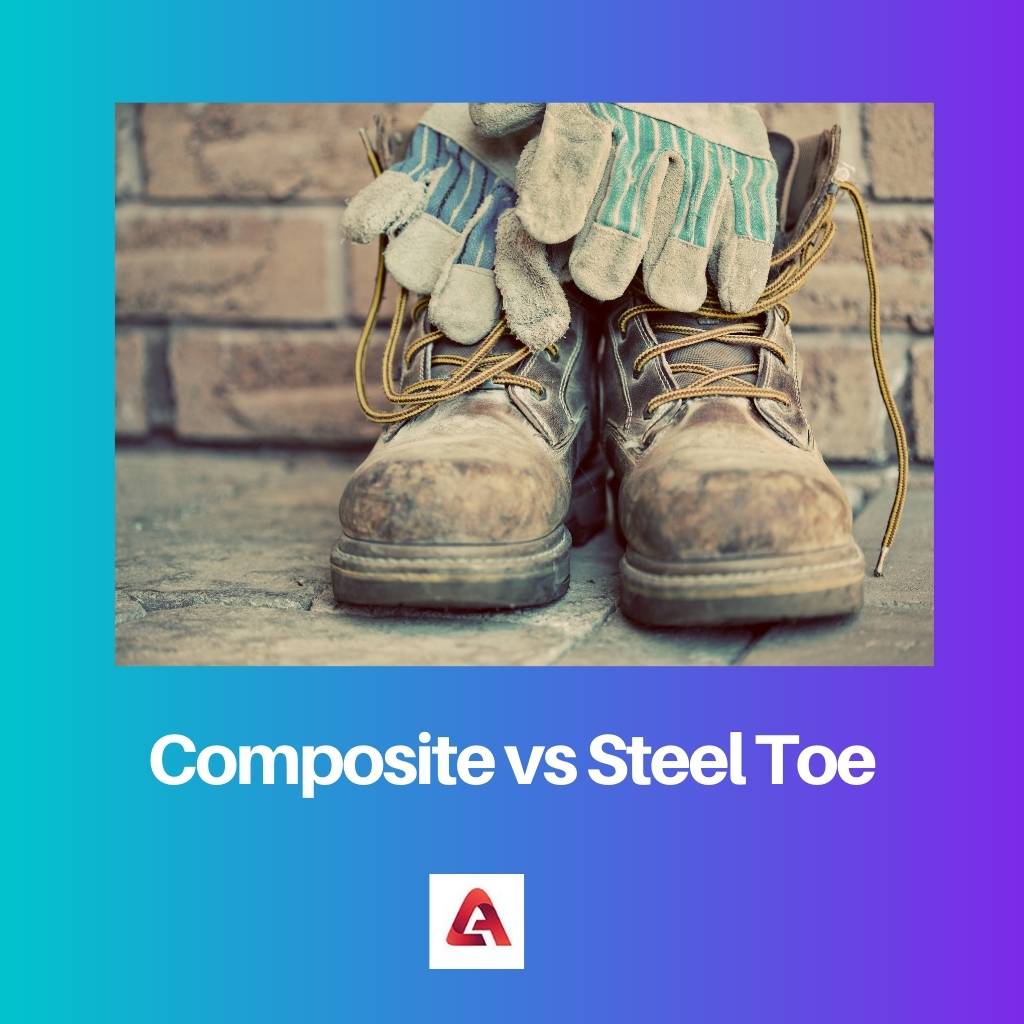Workplace safety is an important factor, and there are many measures used to implement it efficiently.
Workplace boots are the last resort when it comes to workplace safety after various other important methods.
It is used to prevent foot injury possibly caused by something falling onto it, rolling through it, or scenarios in which the blades of any equipment lead to a foot injury.
Key Takeaways
- Composite toe boots use non-metallic materials like plastic or carbon fiber, while steel toe boots incorporate steel for reinforcement.
- Composite toe boots are lighter and offer better insulation, while steel toe boots provide more impact protection.
- Steel toe boots may set off metal detectors, while composite toe boots are metal-free and suitable for high-security workplaces.
Composite vs Steel Toe
Steel-toe boots offer more protection than composite-toe boots and are less expensive than composite-toe boots. Steel toe boots are heavier and do not breathe as well as composite toe boots, further making them difficult to wear. Composite toes are more bulbous than Steel toes.

Composite-toed safety shoes are relatively new and were manufactured much later than their predecessor, the steel toes safety shoes.
They are much almost 30% or sometimes even more light than their traditional counterparts.
It is made up of different non-metals, which offer greater strength and resistance when moulded together to form another compound.
Steel-toed safety shoes were invented a long time ago and were the top choice for work boots until the invention of composite-toe boots.
It got its name because the toe cap of the shoes is made from steel to prevent the foot from getting injured. It weighs around 1.2 to 2 kg.
Comparison Table
| Parameters of Comparison | Composite Toe | Steel Toe |
|---|---|---|
| Comfort | Composite-toed safety shoes tend to be more comfortable to wear because of their lighter weight. | Steel-toed shoes are less comfortable than its counterpart because it is comparatively higher. |
| Weather-friendly | Composite ted shoes are the best work shoes for the cold as it provides better insulation. | Therefore, it offers no insulation as it is made from metal, hence is not ideal for cold weather. |
| Price | Composite-toed shoes are expensive compared to steel toes. | Steel-toed shoes are less expensive compared to composite toes. |
| Appearance | Composite toed shoes are bulky because it provides more room in the toe box. | Steel toes shoes are less bulky but, it provides less toe box room. |
| Electric Resistance | Since it is made up of non-metals, it offers great electrical resistance. | Since it is made from metal, it provides poor electrical resistance. |
| Metal-friendly | Composite toes shoes are made up of non-metals. Hence, it doesn’t set off metal detectors. | Steel toes shoes are made from metal. Hence, it sets off metal detectors. |
What is Composite Toe?
Composite tie shoes were invented because the traditional steel-toed shoes had their faults. Steel toe work boots were heavier and had less room in the toe box.
Composite toe boots are more than 30% lighter than their steel counterpart, making them a clear winner when it comes to the category of the comfort of the wearer.
The toe cap was made of non-metals like plastics, carbon fibre, fibreglass, etc. It made the shoe lighter and made them security-friendly as the shoes don’t set off metal detectors.
However, some composite-toed shoes set off metal detectors due to the steel shank present in some shoes.
Since it has non-metal components, it offers poor electric and thermal conductivity.
These factors make it perfect for handling electric equipment due to its high electric resistance and make it comfortable to wear in cold weather due to the proper insulation offered by the shoes.
It looks bulkier than steel-toe safety shoes because of a roomy toe box.
Although it is more expensive than steel-toed shoes, it is vastly gaining popularity because of the many other benefits it offers.

What is Steel Toe?
Steel toe shoes were the popular choice for workplace safety boots before their more comfortable and beneficial counterpart, the composite toe shoes, took the market by storm.
Steel toe shoes consist of a toecap which is made from steel, as the name suggests. These toe caps act as a protective reinforcement to prevent any injury to the foot.
The only area where steel-toe boots are ahead of composite boots is that it provides great puncture protection compared to composite-toe shoes.
Puncture protection of safety shoes is their ability to protect the feet from sharp objects that can puncture them.
However, composite shoes have a lot more to offer than traditional steel-toe boots and hence, are more expensive.
Steel toe shoes are not preferred in workplaces with metal detectors, such as airports or nuclear work environments, as the steel toe cap sets it off.
It provides poor electric and thermal resistance since its toe cap is manufactured in metal. Since it is heaviest, it may cause fatigue to the joints of the feet and legs.

Main Differences Between Composite and Steel Toe
- Composite-toed safety shoes tend to be more comfortable to wear because of their lighter weight than steel-toe shoes. Steel-toed shoes are less comfortable.
- Composite Ted shoes are the best work shoes for the cold as it provides better insulation than steel-toe boots.
- Composite-toed shoes are expensive compared to steel toes.
- Composite toe shoes are bulkier when compared to steel toe shoes because it has more room in the toe box than its steel counterpart.
- Composite toe shoes offer great electrical resistance since it is made up of non-metals. Steel toe boots offer poor electric resistance since it is made from steel, a metal.
- Composite toe shoes are made up of non-metals. Hence, it doesn’t set off metal detectors. However, steel toes shoes are made from metal and set off metal detectors.

- https://www.sciencedirect.com/science/article/pii/S0169814197000747
- https://search.proquest.com/openview/da033ffc7f8e3d044fc8dc8d898eb4f7/1?pq-origsite=gscholar&cbl=47267
- https://search.informit.org/doi/abs/10.3316/informit.281786442964211

The detailed explanations of the composite toe and steel toe boots’ construction, benefits, and applications in different work environments contribute to a comprehensive understanding of workplace safety footwear options.
The article’s focus on the features, comfort, and material composition of composite toe and steel toe boots deepens readers’ knowledge and fosters an informed approach to workplace safety equipment.
I completely agree. The article provides a holistic view of the key considerations when selecting safety boots, enabling readers to make well-informed decisions based on their requirements.
The comparison provided in the article is valuable in understanding the advantages and disadvantages of composite toe and steel toe boots. It offers a comprehensive analysis of various factors to consider.
Absolutely, the detailed comparison ensures that individuals can assess which type of safety boot is best suited for their work environment and requirements.
The article’s explanation of electric resistance, thermal conductivity, and metal detector compatibility adds depth to the discussion of composite toe and steel toe boots, enhancing readers’ understanding.
The article deepens readers’ knowledge of composite toe and steel toe boots through its informative content, enabling individuals to make well-informed decisions when it comes to workplace safety footwear.
This piece offers a detailed and insightful analysis of composite toe and steel toe boots, shedding light on their unique characteristics and benefits, especially highlighting the advantages of composite toe boots.
The comprehensive comparison of composite toe and steel toe boots, including their features, functionalities, and historical background, equips readers with valuable insights for selecting the most suitable safety boots for their work environment.
Absolutely. The article’s detailed analysis of safety footwear options enhances readers’ ability to assess the safety features that align with their specific work conditions and requirements.
The article explains the development and advantages of composite toe safety shoes very effectively. It clearly outlines how composite toe boots have improved upon traditional steel toe boots in terms of comfort, insulation, and metal-friendliness, despite being more expensive.
I agree, the focus on the advantages of composite toe boots over steel toe boots is well-documented in the article. It highlights the importance of evolving safety measures in the workplace.
I found the information on composite toe shoes being more comfortable due to their lighter weight and better insulation very intriguing. The advancement in workplace safety measures is evident.
The article provides detailed information about the material, weight, and other factors that differentiate composite toe and steel toe boots, helping readers make informed decisions.
Yes, it’s essential to consider both comfort and safety features when selecting workplace safety boots. This article highlights the key aspects effectively.
The comparison between composite toe and steel toe boots, along with their functionalities in terms of electric resistance, metal detector compatibility, and puncture protection, enables readers to assess their workplace safety needs effectively.
I agree. The article’s comprehensive coverage of the distinctive features of composite toe and steel toe boots supports readers in making informed decisions regarding workplace safety footwear.
Absolutely. The article’s emphasis on various safety features equips readers with valuable insights to consider when choosing the appropriate type of safety boots for their work environment.
The details about the differences between composite toe and steel toe boots are comprehensive, particularly the information on comfort, puncture protection, and electric resistance. It’s clear that composite toe boots have several advantages over steel toe boots, making them worth the investment.
Absolutely, the article effectively emphasizes the benefits of composite toe boots in various aspects. Workplace safety is evolving for the better.
The comparison between composite toe and steel toe boots, along with the detailed insights into their individual features, provides a clear understanding of their differences. It’s evident that composite toe boots offer several advantages, despite being more expensive.
Indeed, the article provides valuable information that emphasizes the importance of adopting advanced safety footwear in the workplace. The focus on workplace safety is crucial.
The detailed descriptions and comparisons provided in the article are enlightening, offering readers a comprehensive understanding of the differences and advantages of composite toe and steel toe boots.
Indeed. The article’s emphasis on comfort, insulation, electric resistance, and other critical factors facilitates a nuanced evaluation of the suitability of safety boots for various work environments.
The article effectively highlights the key differences and advantages of composite toe boots over steel toe boots, particularly emphasizing their comfort, insulation, and non-metal composition. The detailed comparison table is very informative.
Absolutely, the article’s in-depth focus on the development and benefits of composite toe boots showcases the importance of investing in advanced safety footwear for the workplace.
I couldn’t agree more. The emphasis on the advanced features of composite toe boots provides a comprehensive understanding of their benefits over traditional steel toe boots.
The article’s detailed description of composite toe and steel toe boots, including their composition, weather-friendliness, price, and appearance, supports informed decision-making when choosing workplace safety shoes.
Absolutely. The comparison table and thorough explanations significantly aid readers in evaluating which type of safety boot aligns with their specific needs and work conditions.
The article effectively presents the advantages of composite toe boots over steel toe boots, highlighting the improvements in comfort, insulation, and overall safety. The detailed comparison table provides valuable insights into their differences.
Absolutely, the article effectively outlines the superior features and benefits of composite toe boots, emphasizing the importance of prioritizing advanced safety footwear in the workplace.
I completely agree. The focus on composite toe boots as a more advanced and comfortable safety footwear option is well-supported by the detailed analysis and comparison provided in the article.
The historical context provided about the invention and evolution of composite toe and steel toe boots enriches the readers’ understanding of the benefits and limitations of each type of safety shoe.
Agreed, the article effectively highlights how advances in safety footwear have led to the development of composite toe boots, addressing the shortcomings of traditional steel toe shoes.
The detailed comparison and analysis of composite toe and steel toe boots provide valuable insights into their differences, especially in aspects like comfort, puncture protection, and electric resistance. It’s evident that composite toe boots offer more advanced safety features.
The comprehensive comparison between composite toe and steel toe boots effectively clarifies their distinct features and benefits. It’s evident that composite toe boots have advantages such as better insulation and comfort despite being pricier.
Absolutely, the article excellently presents the evolution of workplace safety footwear and how composite toe boots have emerged as a superior option. The emphasis on safety and comfort is noteworthy.
The article presents a clear distinction between composite toe and steel toe boots, their benefits, and drawbacks. It’s important to evaluate all aspects to choose the best option for the workplace.
I agree, it’s crucial to understand the features and differences of safety boots to ensure the well-being of workers.
The comparison between composite toe and steel toe boots demonstrates the evolution of workplace safety measures through advanced safety footwear. The benefits of composite toe boots, despite being more expensive, are evident from the detailed analysis.
The comparison table presented is very detailed and informative. It provides great insight into the differences between composite toe and steel toe shoes in various aspects such as comfort, weather-friendliness, price, appearance, electric resistance, and metal-friendliness.
I completely agree. The comparison table makes it easier to understand the key differences between composite toe and steel toe shoes.